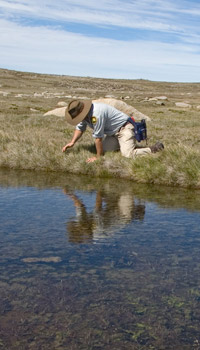Field Trips
The living collection of the ANBG is based on a scientific collection of plants sourced from the wild, together with seeds collected for long-term storage in the seed bank. Pressed herbarium specimens and photographs formalise the process of collecting.
Alpine Field Trips
During the years 2007-10, and in response to the increasing threat of climate change and human impact on our alpine flora, the Gardens has undertaken field trips to Australia's alpine region. The ANBG has identified this nationally significant ecosystem as a focus for its future collection and research activities.
Multiple visits across the Kosciusko alpine regions were made with the aim of collecting seeds from alpine plant species above the tree-line. Each visit focussed on a different area and had its own list of targeted species. The ANBG seed bank curator and horticulturists were accompanied by NSW National Parks and Wildlife Service (NPWS) rangers and scientists from nearby Jindabyne and Queanbeyan. All relevant NPWS permits were obtained and permit conditions followed for the collection of seed and herbarium specimens.
The key vegetation communities collected from were:
- Heathland
- Sod-Tussock Grassland
- Bogs and Fens
- Tall Alpine Herbfield
- Short Alpine Herbfield
- Feldmarks (a community of prostrate plants on stony ground)
Examples of the types of plants found in these communities include:
- Alpine Orites (Orites lancifolia)
- Shaggy Pea (Oxylobium ellipticum)
- Matted Nertera (Nertera granadensis)
- Wedge Oschatzia (Oschatzia cuneifolia)
- Kosciuszko Aniseed (Gingidia algens)
- Herbfield Celmisia (Celmisia costiniana)
- Purple Eyebright (Euphrasia collina subsp. diversicolor)
- Snowpatch Daisy (Parantennaria uniceps)
- Alpine Marsh-marigold (Psychrophila introloba)
- Feldmark Grass (Rytidosperma pumilum)
- Feldmark Snow-hebe (Chionohebe densifolia)
- Snow Heath (Epacris petrophila)
- Dwarf Fleabane (Erigeron setosus)
ARC Linkage Grant
On 1st June 2009, the Australian Research Council (ARC) awarded a linkage grant of $250,000 for a three year project to continue the alpine seed bank conservation work and to research the plants' adaptations to climate change. The project is a collaboration between the Australian National University, University of Queensland, the Friends of the ANBG and the ANBG and will fund a post-doctoral fellowship and a PhD scholarship.
The ANBG seed bank holds the largest national collection of alpine seeds and is the only seed bank that focuses on collecting all alpine seeds endemic or obligate (limited distribution) to the region. The project will build on the conservation and research capacities of the ANBG seed bank.
The project will:
- investigate methods for breaking alpine seed dormancy and conduct germination trials
- conduct field and glasshouse studies on alpine seed longevity, viability and set
- study the effect that climate change could have on alpine plant morphology and phrenology (flowering)
- identify indicator species for long-term monitoring of alpine species in a network of in situ sites
- cultivate alpine plants locally and develop alpine horticultural / plant propagation expertise
These efforts will help ensure long term ex situ conservation of alpine species and develop techniques for restoration and rehabilitation. An alpine garden using a small percentage of the alpine seeds to aid community education and awareness is proposed.
BLOSSOMING FUTURE FOR DELICATE NATIVE SHRUB - Pomaderris delicata
Gardens staff joined volunteers and staff from NSW Department of Environment to plant 500 plants of the critically endangered Delicate Pomaderris shrub (Pomaderris delicata). It's estimated that less than 100 of these plants remained in the wild before the planting.
Gardens experts have grown the plants from cuttings taken in 2014 after field attempts to collect seed for propagating were unsuccessful. This successful initiative can guide future threatened species recovery actions and open the door for similar efforts where seed is unavailable or is challenging to germinate.
Video - Pomaderris delicata translocation
![Director of National Parks [logo]](../../../images/dnp_90px.gif)






